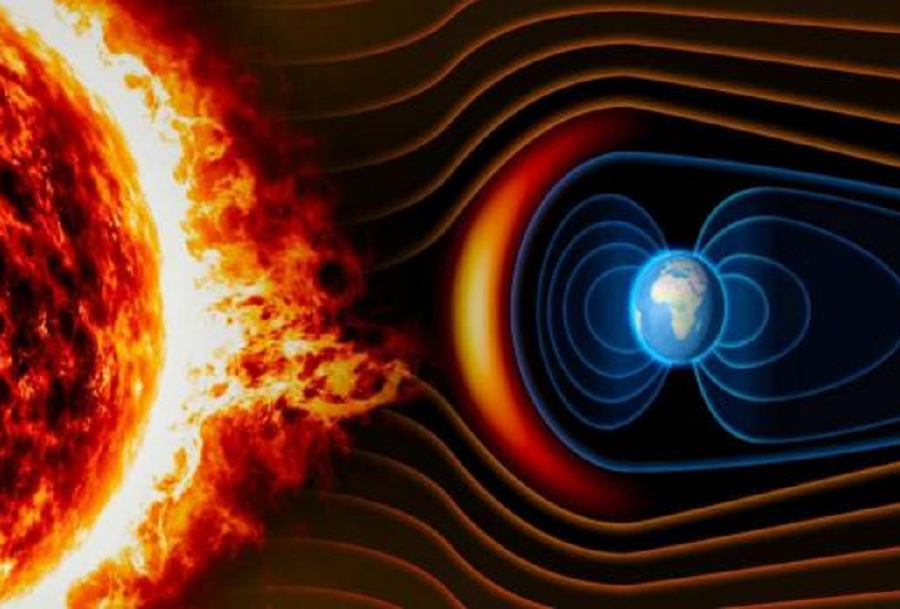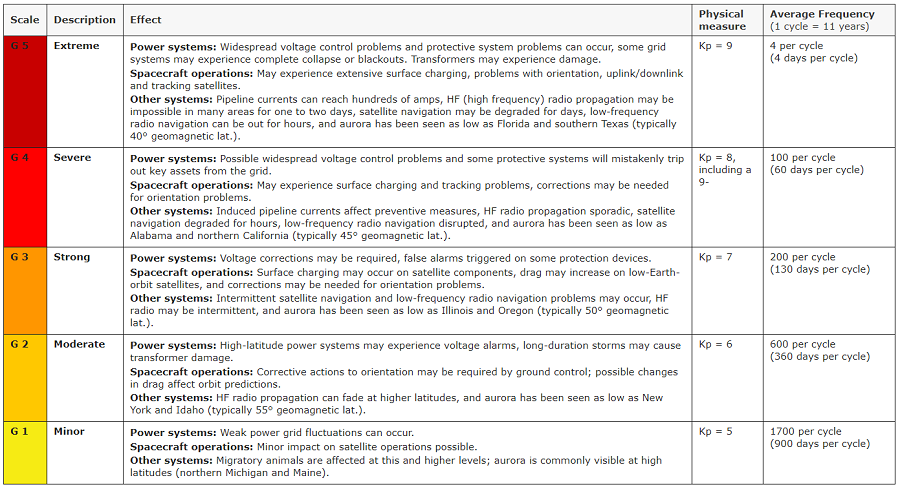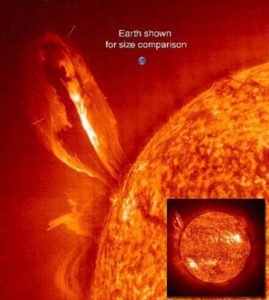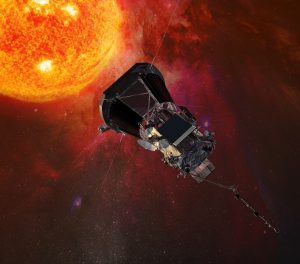
The sun has exploded to life, erupting several major solar flares and two coronal mass ejections towards Earth. The dual coronal mass ejections (CME) are due to merge and strike Earth on Thursday with significant impacts expected; due to that threat, NOAA’s Space Weather Prediction Center has issued a Geomagnetic Storm Watch (G3) for a strong storm. This strong storm may even be stronger, with a 4 or 5 storm possible on a 1-5 scale of geomagnetic storm. In addition to pushing the aurora south into the United States, there could be very significant impacts to electrical systems including power grids and power plants, radio and satellite communications, and navigation systems.
Due to the threat of damage to electronics and computer systems, the National Weather Service has declared a “Critical Weather Day” through Friday night due to the geomagnetic storm. “Critical Weather Day will continue…for space weather concerns…with a G3 geomagnetic storm and potential for higher (G4/G5) forecasted later this week,” the Senior Duty Meteorologist for the National Weather Service wrote in a bulletin. “All scheduled software/hardware/network changes for the impacted offices will be postponed until the Critical Weather Day has ended. Any emergency changes will be evaluated and approved by regional management officials or their designees. National Weather Service offices should contact their regional offices for further questions about this Critical Weather Day.” This declaration impacts NCEP and NCF divisions. NCEP, short for National Centers for Environmental Prediction, includes the Climate Prediction Center, the National Hurricane Center, the Space Weather Prediction Center, the Weather Prediction Center, Storm Prediction Center, and Environmental Modeling. NCF involves the Advanced Weather Interactive Processing System (AWIPS) Network Control Facility.
Anyone that uses electricity or any electronic device should also be aware of the strong geomagnetic storm threat.
If a severe G4 or extreme G5 geomagnetic storm ever materialized, it would be life altering on Earth, creating extensive damage to anything that runs on electricity. These types of storms have impacted Earth before, but in times before the proliferation of electricity, computers, the internet, and satellite communications.

However, even a strong G3 storm can create many issues. Power systems could develop issues or fail while high frequency radio communications could be blacked-out or intermittent. Satellite communication and low-frequency radio navigation problems could also occur.
These outages may also knock off-line emergency communication systems and radios used by first responders. Because this geomagnetic storm is expected to unfold on the same day as a significant severe weather outbreak in the United States, the geomagnetic storm could have implications to the Earth weather storms and how emergency response can react.
While the impacts of geomagnetic disturbances usually aren’t visible to the eye, they can instigate aurora to appear much further south than usual. While aurora, also known as the Northern Lights, is visible in high latitudes in Alaska and central and northern Canada, this geomagnetic storm could push aurora deep into the United States. The Space Weather Prediction Center says it is possible that aurora can shine as far south as Oregon, Iowa, and Pennsylvania; it is also possible aurora could appear more south than that if the geomagnetic storm was stronger than currently forecast.
While these solar events can help illuminate the sky with stunning aurora, they can also do considerable harm to electronics, electrical grids, and satellite and radio communications.

The 1859 incident, which occurred on September 1-2 in 1859, is also known as the “Carrington Event.” This event unfolded as powerful geomagnetic storm struck Earth during Solar Cycle 10. A CME hit the Earth and induced the largest geomagnetic storm on record. The storm was so intense it created extremely bright, vivid aurora throughout the planet: people in California thought the sun rose early, people in the northeastern U.S. could read a newspaper at night from the aurora’s bright light, and people as far south as Hawaii and south-central Mexico could see the aurora in the sky.
The event severely damaged the limited electrical and communication lines that existed at that time; telegraph systems around the world failed, with some telegraph operators reporting they received electric shocks.
A June 2013 study by Lloyd’s of London and Atmospheric and Environmental Research (AER) in the U.S. showed that if the Carrington event happened in modern times, damages in the U.S. could exceed $2.6 trillion, roughly 15% of the nation’s annual GDP.
More than 17 solar flares erupted from the sun yesterday; 11 were C-class and 6 were M-class. Solar flares are giant explosions on the sun that send energy, light and high speed particles into space. These flares are often associated with solar magnetic storms known as coronal mass ejections (CMEs). Flares are ranked on a classification system that divides solar flares according to their strength. The smallest ones are A-class (near background levels), followed by B, C, M and X. Similar to the Richter scale for earthquakes, each letter represents a 10-fold increase in energy output. So an X is ten times an M and 100 times a C. Within each letter class there is a finer scale from 1 to 9. C-class and smaller flares are too weak to noticeably affect Earth. M-class flares can cause brief radio blackouts at the poles and minor radiation storms that might endanger astronauts. According to NASA, although X is the last letter, there are flares more than 10 times the power of an X1, so X-class flares can go higher than 9. NASA says the most powerful flare measured with modern methods was in 2003, during the last solar maximum, and it was so powerful that it overloaded the sensors measuring it. Those sensors cut out at X28.

Yesterday’s solar explosion created a radio black-out and radiation storm on Earth. The radiation blasts associated with solar flares may not only bring harm to astronauts in space, but to airline passengers and crew on Earth. According to NOAA’s Space Weather Prediction Center (SWPC), “An enhancement in the energetic portion of the solar radiation spectrum may indicate increased biological risk to astronauts or passengers and crew in high latitude, high altitude flights.” Beyond impacting humans, the excess radiation could also harm electronics. “Energetic particles may represent an increased risk to all satellite systems susceptible to single event effects. This information should be used in conjunction with the current Solar Radiation Storm conditions when assessing overall impact,” the SWPC said in a bulletin yesterday.
While typically known for their weather forecasts, the National Oceanic and Atmospheric Administration (NOAA) and its National Weather Service (NWS) is also responsible for “space weather.” While there are private companies and other agencies that monitor and forecast space weather, the official source for alerts and warnings of the space environment is the Space Weather Prediction Center (SWPC). The SWPC is located in Boulder, Colorado and is a service center of the NWS, which is part of NOAA. The Space Weather Prediction Center is also one of nine National Centers for Environmental Prediction (NCEP) as they monitor current space weather activity 24/7, 365 days a year.